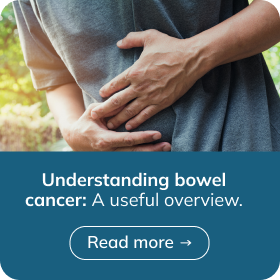
![]()
Gastroenterology
Our thorough gastroenterologists, endoscopists and interventional endoscopists provide timely access to diagnose and manage disease of the gastrointestinal system, including the oesophagus, stomach, intestines, liver, pancreas, gallbladder, and bile ducts.
Gastroenterologists perform diagnostic procedures like endoscopies and colonoscopies and interventional procedures to treat conditions.
Bowel cancer
Also known as colorectal cancer, is one of the most common types of cancer. It affects the colon (large intestine) or rectum. It typically begins as benign polyps, which can develop into cancer over time if not detected and removed. Symptoms may include changes in bowel habits (such as diarrhea or constipation), blood in the stool, abdominal pain, unexplained weight loss, and fatigue.
With early detection of bowel cancer, almost 99 percent of cases can be successfully treated.[1]
- From 1 July 2024, the eligible screening age for the National Bowel Cancer Screening Program is lowered for everyone from 50 to 45 years of age.
- For people at average risk of bowel cancer and without symptoms, Australian medical guidelines recommend screening using a faecal immunochemical test (FIT) every 2 years between ages 45-74.
- The guidelines state a healthcare professional could consider offering a faecal immunochemical test every 2 years to people aged 40-44 who request screening, after being fully informed of the benefits and potential harms of testing.
- Similarly, the guidelines state a healthcare professional could consider offering a faecal immunochemical test every 2 years to people aged 75-85 who are fit, well and healthy and request screening, after being fully informed of the benefits and potential harms of testing.[1]
Speak with your GP if you are experiencing symptoms for two weeks or more.
If you've recently done a bowel cancer screening test, you should receive your test results within two weeks. A copy of results will also be sent to the general practitioner (GP) that you nominated on your form. You may be referred on to see one of our experienced Knox Private Hospital Gastroenterologists or Colorectal surgeons for further tests and treatment.
Colitis
Colitis refers to inflammation of the inner lining of the colon. It can be caused by infections, loss of blood supply in the colon, chronic diseases, or inflammatory conditions such as ulcerative colitis.
Crohn’s disease
Crohn's disease is a chronic inflammatory bowel disease (IBD) that can affect any part of the gastrointestinal tract from the mouth to the anus. Symptoms include abdominal pain, severe diarrhea, fatigue, weight loss, and malnutrition.
Funtional gastrointestinal disorders
Functional gastrointestinal disorders involve symptoms arising from how the GI tract functions. Examples include:
- Upper GI functional disorders: Functional dyspepsia (indigestion), characterized by upper abdominal discomfort or pain, bloating, and nausea.
- Lower GI functional disorders: Conditions like IBS, causing symptoms related to abnormal bowel habits and abdominal discomfort.
Gastrointestinal cancers
Cancers that affect the digestive system, including cancers of the esophagus, stomach, liver, pancreas, gallbladder, and intestines are gastrointestinal cancers.
Inflammatory bowel disease (IBD)
IBD is an umbrella term for chronic inflammatory conditions of the gastrointestinal tract, primarily including Crohn's disease and ulcerative colitis. Symptoms often involve severe diarrhea, pain, fatigue, and weight loss.
Irritable bowel syndrome (IBS)
IBS is a common disorder affecting the large intestine, causing symptoms like cramping, abdominal pain, bloating, gas, and diarrhea or constipation, or both. It is a functional gastrointestinal disorder with no visible signs of damage or disease in the digestive tract.
[1] https://www.bowelcanceraustralia.org/symptoms
Procedures
Diagnostic endoscopy
- Gastroscopy - for stomach conditions
A gastroscopy is a procedure where a doctor examines the lining of the upper gastrointestinal tract using a flexible, fiber optic instrument called a gastroscope. It passes through the mouth to inspect the esophagus, stomach, and duodenum. The procedure can also involve taking a small biopsy to diagnose various conditions.
- Colonoscopy - for large bowel problems
A colonoscopy is a procedure where a doctor examines the inside lining of the large bowel using a flexible tube with a camera and light called a colonoscope. The colonoscope can navigate the colon's curves, remove polyps, and take biopsies to diagnose various conditions.
- Capsule Endoscopy (“Pill Cam”) - for small bowel problems
A capsule endoscopy uses a tiny wireless camera inside a vitamin-sized capsule to take pictures of the digestive tract after being swallowed. The camera sends thousands of images to a recorder worn on a belt. This procedure allows visualization of the small intestine, which is hard to reach with traditional endoscopy that uses a flexible tube with a camera passed through the throat or rectum.
- Single/Double Balloon Assisted Enteroscopy - for examining the entire length of digestive tract
A balloon enteroscopy uses a long, thin tube with one or two balloons and a camera to examine the small intestine. The tube reaches the small intestine through the esophagus or rectum, with the balloons inflating to help it advance safely. This procedure diagnoses and treats small bowel issues, gastrointestinal bleeding, suspected malignancies, and Crohn’s disease.
- Flexible sigmoidoscopy - for the sigmoid (a section of large bowel)
A flexible sigmoidoscopy evaluates the lower part of the large intestine. During the procedure, a thin, flexible tube with a camera (sigmoidoscope) is inserted through the rectum, allowing the doctor to view the rectum, sigmoid colon, and descending colon. Tissue samples (biopsies) can be taken if necessary.
- Endoscopic Ultrasound (EUS) - for deeper lining of the gut or organs close to the gut
Endoscopic ultrasound (EUS) is a minimally invasive procedure that uses a flexible tube with an ultrasound device to assess the digestive tract and nearby organs. It produces detailed images of the gastrointestinal tract, lungs, pancreas, gallbladder, liver, and lymph nodes. The tube may also have a needle for biopsies or fluid drainage and can inject drugs at specific sites.
Polyp Surveillance Management
Some patients may be referred to a surgical specialist or back to their GP after colonoscopy and polypectomy for polyp surveillance management. These patients will be sent back with their endoscopy report and histology results.
Interventional endoscopy involves specialised procedures that can diagnose and treat conditions in a minimally invasive manner. These procedures include:
- Endoscopic Retrograde Cholangio - Pancreatography (ERCP) - treating the bile duct and the pancreas
ERCP uses a thin, lighted fiber optic tube with a camera to view organs and detect abnormalities, allowing instruments for biopsies, polyp removal, or solution injection. Dye injected via a flexible video endoscope highlights bile and pancreatic ducts for X-ray imaging.
- Percutaneous Gastrostomy (PEG) - guide the insertion of a tube into your stomach for food and medicine
A PEG procedure is the insertion of a feeding tube through the skin and the stomach wall, directly into the stomach. PEG feeding tube insertion is done in part using a procedure called endoscopy. Feeding tubes are needed when you are unable to eat or drink.
- Endoscopic Mucosal resection of colonic polyps (EMR) - removal of colonic or upper gastrointestinal tract polyps
EMR removes precancerous or early-stage cancer lesions from the digestive tract using a long tube with a camera and instruments. It's performed by passing an endoscope through the throat for upper tract abnormalities or through the rectum for colon lesions. EMR also collects biopsies to assess cancer progression into deeper tissues.
- Oesophageal, duodenal and colonic stenting/ ballooning
Oesophageal, duodenal and Colonic stenting or ballooning is a procedure used to treat obstructed portions of those areas. A flexible, hollow tube expands and opens the blocked section.
- Haemarroid banding and management
This procedure can be performed by a Gastroenterologist or Colorectal surgeon. For more information, visit the following page Colorectal surgery
- Management of bleeding
Involves controlling bleeding and promoting blood clotting to prevent excessive blood loss.
Patient resources




